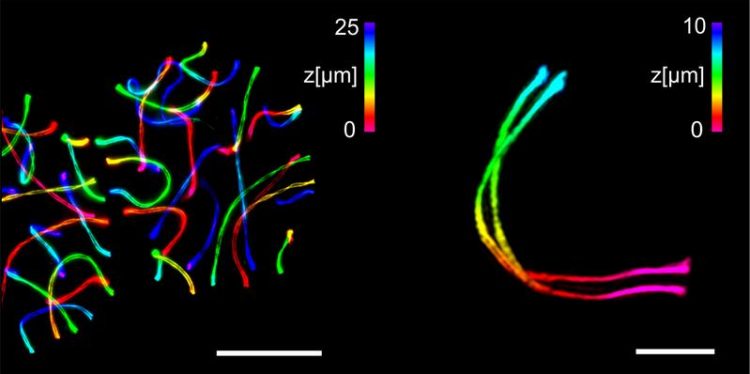High-end Microscopy Refined

Left two sperm-forming cells expanded with ExM-SIM, on the right a detailed 3D image of a single synaptonemal complex. The 3D information is colour-coded. Working groups Benavente/Sauer Biocenter JMU
The synaptonemal complex is a ladder-like cell structure that plays a major role in the development of egg and sperm cells in humans and other mammals.
“The structure of this complex has hardly been changed in evolution, but its protein components vary greatly from organism to organism,” says Professor Ricardo Benavente, cell and developmental biologist at the Biocenter of Julius-Maximilians-Universität (JMU) Würzburg in Bavaria, Germany.
This points to the fact that the structure is crucial for the undisturbed function of the complex. Benavente is investigating the synaptonemal complex together with Markus Sauer, Professor of Biotechnology and Biophysics at the JMU Biocenter. The latest findings of the two research groups have been published in the journal Nature Communications.
The data indicate, among other things, that the synaptonemal complex in the case of the mouse is not, as previously assumed, double-layered, but far more complex.
Sophisticated combination of microscopy techniques
“In our study, we combined structured illumination microscopy SIM with various methods of expansion microscopy ExM,” explains Sauer, who is an expert in high-resolution microscopy. The ExM enables greater resolution by embedding the target structures into a swellable polymer which can be physically ~ 4fold expanded.
ExM in combination with SIM enabled the researchers for the first time to visualize the three-dimensional ultrastructure of the synaptonemal complex by multicolour imaging with a spatial resolution of 20 to 30 nanometres.
“If immunolabeling is performed after expansion of the complex, the antibody accessibility can be improved compared to other high-resolution methods. This has enabled us to decipher details of the molecular organisation that were previously hidden,” said Benavente and Sauer. In addition, the images can now be taken with almost molecular resolution on a standard light microscope.
With the combination of ExM-SIM, the JMU teams are now looking to discover further details of the synaptonemal complex and other multi-protein complexes.
Info box: Synaptonemal complex
The synaptonemal complex is ultimately responsible for the individuality of the human being. It occurs exclusively in the cells from which the egg and sperm cells of humans and other mammals develop. The complex ensures that the chromosomes exchange genetic material with each other. Thus, a subsequent cell division results in the formation of individual egg or sperm cells.
Sponsors
The work described was financially supported by the German Research Foundation (DFG) within the Collaborative Research Center Transregio 166 “ReceptorLight”, by the Boehringer Ingelheim Fund and by a grant from the Howard Hughes Medical Institute (HHMI).
Prof. Dr. Ricardo Benavente, Cell and Developmental Biology, Biocenter, University of Würzburg, T +49 931 31-84254, benavente@biozentrum.uni-wuerzburg.de
Prof. Dr. Markus Sauer, Biotechnology and Biophysics, Biocenter, University of Würzburg, T +49 931 31-88687, m.sauer@uni-wuerzburg.de
Tracking down the molecular architecture of the synaptonemal complex by expansion microscopy, Nature Communications, DOI: 10.1038/s41467-020-17017-7
Media Contact
More Information:
http://www.uni-wuerzburg.deAll latest news from the category: Life Sciences and Chemistry
Articles and reports from the Life Sciences and chemistry area deal with applied and basic research into modern biology, chemistry and human medicine.
Valuable information can be found on a range of life sciences fields including bacteriology, biochemistry, bionics, bioinformatics, biophysics, biotechnology, genetics, geobotany, human biology, marine biology, microbiology, molecular biology, cellular biology, zoology, bioinorganic chemistry, microchemistry and environmental chemistry.
Newest articles

High-energy-density aqueous battery based on halogen multi-electron transfer
Traditional non-aqueous lithium-ion batteries have a high energy density, but their safety is compromised due to the flammable organic electrolytes they utilize. Aqueous batteries use water as the solvent for…

First-ever combined heart pump and pig kidney transplant
…gives new hope to patient with terminal illness. Surgeons at NYU Langone Health performed the first-ever combined mechanical heart pump and gene-edited pig kidney transplant surgery in a 54-year-old woman…

Biophysics: Testing how well biomarkers work
LMU researchers have developed a method to determine how reliably target proteins can be labeled using super-resolution fluorescence microscopy. Modern microscopy techniques make it possible to examine the inner workings…





















